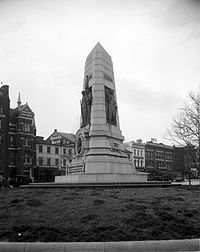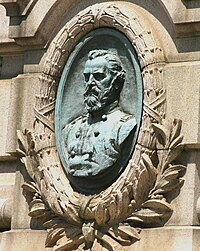Stephenson Grand Army of the Republic Memorial
 | |
 | |
| Location | Indiana Plaza,Washington, D.C.,United States |
|---|---|
| Designer | J. Massey Rhind(sculptor) Rankin, Kellogg & Crane (architects) Roman Bronze Works(founder) William Gray & Sons, P. R. Pullman and Company (contractors) |
| Material | bronze (sculpture) granite (shaft) concrete (base) |
| Height | 25 feet (7.6 m) (shaft) 2 feet (0.61 m) (base) |
| Opening date | July 3, 1909 |
| Dedicated to | Benjamin F. Stephenson |
Stephenson Grand Army of the Republic Memorial | |
| Coordinates | 38°53′36.9″N77°1′17.7″W/ 38.893583°N 77.021583°W |
| Part of | Civil War Monuments in Washington, D.C. |
| NRHP referenceNo. | 78000257[1] |
| Added to NRHP | September 20, 1978[2] |
TheStephenson Grand Army of the Republic Memorial,also known asDr. Benjamin F. Stephenson,is a public artwork inWashington, D.C.honoring Dr. Benjamin F. Stephenson, founder of theGrand Army of the Republic,a fraternal organization forUnionveterans. The memorial is sited at Indiana Plaza, located at the intersection of7th Street,Indiana Avenue, andPennsylvania AvenueNW in thePenn Quarterneighborhood. The bronze figures were sculpted byJ. Massey Rhind,a prominent 20th-century artist. Attendees at the 1909 dedication ceremony included PresidentWilliam Howard Taft,SenatorWilliam Warner,and hundreds of Union veterans.
The memorial is one ofeighteen Civil War monumentsin Washington, D.C., which were collectively listed on theNational Register of Historic Placesin 1978. The bronze sculptures of Stephenson and allegorical figures are displayed on a triangular granite shaft surmounting a concrete base. The memorial is owned and maintained by theNational Park Service,a federal agency of theInterior Department.
History[edit]
Background[edit]
Benjamin F. Stephenson (1823–1871) was a graduate ofRush Medical Collegewho practiced medicine inPetersburg,Illinois.When theCivil Warbegan in 1861, he was appointed surgeon of the14th Illinois Volunteer Infantry Regiment.Eventually, he achieved the rank ofmajor.Following his honorable discharge in 1864, Stephenson began practicing medicine inSpringfield,Illinois, and soon began plans for a national association ofUnionveterans.[3]He named the new organization theGrand Army of the Republic(GAR), wrote the GAR's constitution and adopted the GAR motto "Fraternity, Charity, and Loyalty". The organization would be open to all Union soldiers and sailors who were honorably discharged. Stephenson found a lack of enthusiasm for the GAR among Springfield veterans, so he chose nearbyDecaturto establish Post No. 1, Decatur, Department of Illinois, Grand Army of the Republic, on April 6, 1866.[4]The date was the fourth anniversary of theBattle of Shilohwhere he and most of the other charter members had taken part. After the GAR began to attract new members, Stephenson was relegated to adjutant general and spent most of his time attending to routine duties. At the time of his death in 1871, Stephenson's medical practice was failing, and he felt the GAR would never succeed.[3]

Following Stephenson's death, the GAR grew from a charitable organization for Union widows and wounded veterans to the country's most powerful single-issue political group in the late 19th century.[3]It was the nation's first veterans association open to both officers and enlisted men, and membership grew to over 400,000.[5]The GAR was responsible for securing large pensions for veterans and members played an active role in the election of six Union veterans as U.S. president. In the early 20th century, GAR membership declined as veterans died of old age, and organization leaders began plans to memorialize them and the GAR itself. To honor the group's founder, the GAR, at the behest of General Charles Partridge and theNational Tribune,raised $35,000 from its members to erect a memorial for Stephenson.[3][5]Congressappropriated an additional $10,000 on March 4, 1907.[3][6]
GAR leaders had specific plans for the memorial, which left little leeway for artist creativity. They wanted a tall, triangular granite shaft with three figures representing the organization's motto.J. Massey Rhind(1860–1936), a Scottish-American sculptor who immigrated to the United States in 1889, was chosen for the project. At the time, he was considered one of the country's best architectural sculptors known for the largeSoldiers and Sailors MonumentinSyracuse,New York.[3]The architectural firm Rankin, Kellogg & Crane was chosen to design the central shaft of the memorial, and the reliefs werefoundedbyRoman Bronze Works.William Gray & Sons performed contracting duties for the memorial, and P. R. Pullman and Company was chosen as the contractor for the foundation.[6]
A resolution passed by theSenatein April 1902 provided the memorial to be erected on any of the city's public lands other than theLibrary of CongressandCapitolgrounds.[7]The site chosen, at the corner of7th Streetand Louisiana Avenue (now Indiana Avenue) NW, was selected by a commission appointed by Congress. The commission consisted of Secretary of WarJacob M. Dickinson,SenatorGeorge P. Wetmore,RepresentativeSamuel W. McCall,GeneralLouis Wagner,and Thomas S. Hopkins.[8]The soil at the chosen site, present-day Indiana Plaza, could not support the memorial's weight, so the concrete foundation had to be expanded.[6]
Dedication[edit]
The Stephenson memorial was formally dedicated at 2:30 pm on July 3, 1909.[5]Hundreds of elderly veterans attended the event, many wearing their military uniforms. Prominent attendees included PresidentWilliam Howard Taftand SenatorWilliam Warner.[3]Following the invocation, GAR commander-in-chief ColonelHenry M. Neviusgave an impassioned speech about the sacrifices made by Union forces during the Civil War. He said by the shedding of their blood, "the flag of the United States has been raised from the dust and mire, smoke begrimed, powder stained and bullet ridden and thrown to the breeze to float forever over our broad land of the free."[3]
Taft paid tribute to the sacrifices made by veterans and accepted the memorial on behalf of the American people. Following his speech, Warner told the crowd: "Boys, the President of the United States talks like a comrade. Get up on your feet, all of you, now three cheers for the President of the United States." The president and Rhind, who was introduced to the crowd, were both cheered. After the ceremony, theMarine Bandplayed "Tenting on the Old Camp Ground"as the veterans sang.[3]Brigadier GeneralWilliam Wallace Wotherspoonserved as the grand marshal of a military parade that marched fromCity Hall,past the memorial, west onPennsylvania Avenueto theTreasury Building,and ended at 15th Street andNew York Avenue.[5]
Later history[edit]
In 1987, the Pennsylvania Avenue Development Corporation created Indiana Plaza by closing a portion of C Street, decreasing the width of Indiana Avenue, and adding landscaping. The process required relocating the memorial and nearbyTemperance Fountain.The Stephenson memorial is now visible at the terminus of C Street. The fountain now stands where the Stephens memorial was previously located.[9]
The memorial is one ofeighteen Civil War monumentsin Washington, D.C., which were collectively listed on theNational Register of Historic Placeson September 20, 1978, and theDistrict of Columbia Inventory of Historic Siteson March 3, 1979.[2][10]It is also designated acontributing propertyto thePennsylvania Avenue National Historic Site,established on September 30, 1965.[9]The memorial and surrounding plaza are owned and maintained by theNational Park Service,a federal agency of theInterior Department.[6]
Design and location[edit]
The memorial is located at Indiana Plaza (Reservation 36A) in thePenn Quarterneighborhood. The small public plaza, located across the street from theArchivesMetrostation, is bounded by 7th Street to the west, Indiana Avenue to the north, andPennsylvania Avenueto the south. Two historic buildings bound the east side of the plaza:Central National BankandNational Bank of Washington, Washington Branch.Sited directly to the north of the memorial is the historic Temperance Fountain.[9]The memorial is sited within a circular plaza and surrounded bymagnoliatrees and ivy. Decorative lampposts are located at the three entrances.[9]
The triangular shaft, consisting of granite blocks, is 25 ft (7.6 m) tall and surmounts a 2 ft (0.61 m) concrete base. On each side of the shaft is a bronzerelief.On the front (west) side is a relief of aUnion soldierandUnion sailorsymbolizing Fraternity. The soldier is holding a gun with his right hand, and to his left, the sailor holds theAmerican flagwith his right hand. The word FRATERNITY is located on the bottom of the relief. Below the Fraternity relief is a reliefbustof Stephenson dressed in military uniform. The bust is displayed on a bronze medallion installed in a circular niche decorated with foliage. Below the Stephenson relief is an inscription flanked by Grand Army of the Republic emblems. On the northeast side of the memorial, the relief depicts a woman cloaked in a long robe and cape protecting a small child standing to her left. She touches the child's shoulder with her left hand, and the word CHARITY is on the bottom of the relief. A woman holding a shield and drawn sword is on the southeast side of the memorial. The word LOYALTY is located on the bottom of the relief.[6]
Inscriptions on the memorial include the following:[3][6]
- 1861 1865 (upper portion of shaft, above the Union soldier and sailor relief)
- FRATERNITY (on relief, below the soldier and sailor)
- GRAND ARMY OF THE REPUBLIC / ORGANIZED AT DECATUR ILLINOIS, APRIL 6, 1866 / BY BENJAMIN FRANKLIN STEPHENSON M.D. (lower portion of the shaft, below the Stephenson relief)
- CHARITY (on relief, below the Charity figure)
- THE GREATEST / OF THESE IS / CHARITY (lower portion of the shaft, below the Charity relief)
- LOYALTY (on relief, below the Loyalty figure)
- WHO KNEW NO / GLORY BUT HIS / COUNTRY'S GOOD (lower portion of the shaft, below the Loyalty relief)
See also[edit]
References[edit]
- ^"National Register Information System".National Register of Historic Places.National Park Service.July 9, 2010.
- ^ab"District of Columbia Inventory of Historic Sites"(PDF).District of Columbia Office of Planning – Historic Preservation Office. September 30, 2009. Archived fromthe original(PDF)on November 5, 2014.RetrievedNovember 21,2015.
- ^abcdefghijJacob, Kathryn Allamong (1998).Testament to Union: Civil War Monuments in Washington, D.C.Baltimore: JHU Press. pp. 71–75.ISBN978-0-8018-5861-1.
- ^Goode, James M. (1974).The Outdoor Sculpture of Washington, D.C.Washington, D.C.: Smithsonian Institution Press. p. 360.ISBN0-87474-149-1.
- ^abcd"Belated Honor Paid".Evening Star.June 27, 1909.Archivedfrom the original on November 22, 2015.RetrievedNovember 21,2015.
- ^abcdef"Stephenson Grand Army of the Republic Memorial, (sculpture)".Smithsonian American Art Museum.Archivedfrom the original on November 22, 2015.RetrievedNovember 21,2015.
- ^"Founder of G.A.R."Evening Star.April 1, 1902.Archivedfrom the original on November 22, 2015.RetrievedNovember 21,2015.
- ^"Grand Army Memorial".Evening Star.May 22, 1909.Archivedfrom the original on November 22, 2015.RetrievedNovember 21,2015.
- ^Scott, Gary (September 19, 1977)."National Register of Historic Places Inventory—Nomination Form – Civil War Monuments in Washington, D.C."National Park Service.RetrievedNovember 21,2015.
External links[edit]
 Media related toStephenson Grand Army of the Republic Memorialat Wikimedia Commons
Media related toStephenson Grand Army of the Republic Memorialat Wikimedia Commons
- 1907 sculptures
- Allegorical sculptures in Washington, D.C.
- Bronze sculptures in Washington, D.C.
- Civil War Monuments in Washington, D.C.
- Concrete sculptures in the United States
- Grand Army of the Republic buildings and structures
- Granite sculptures in Washington, D.C.
- Historic district contributing properties in Washington, D.C.
- Sculptures of men in Washington, D.C.
- Sculptures of women in Washington, D.C.
- Outdoor sculptures in Washington, D.C.
- Penn Quarter
- Sculptures by J. Massey Rhind



